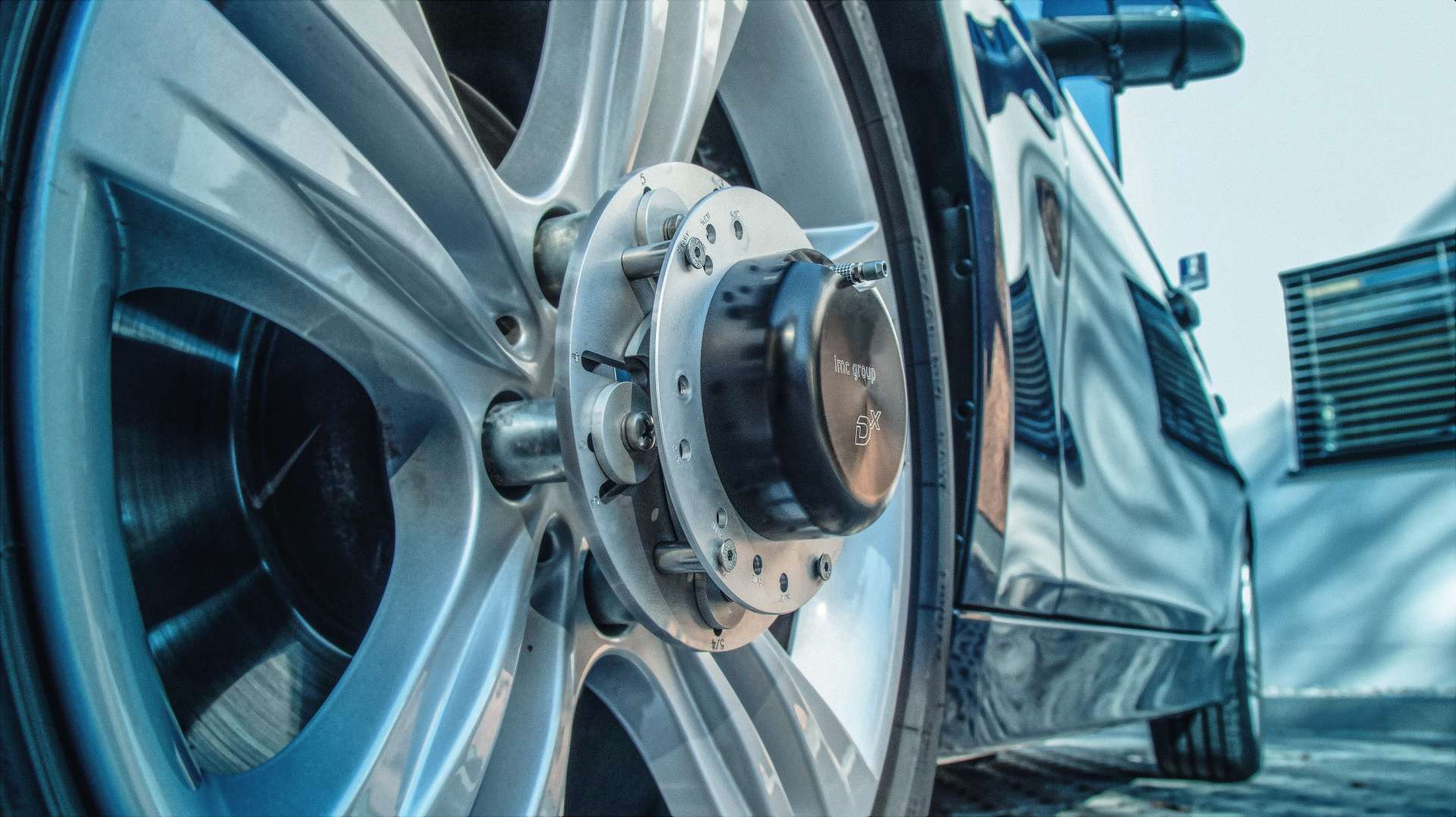Dx-Speed: Innovatives System zur Drehratenmessung an Fahrzeug-Rädern
Ob PKW, Transporter, LKW oder mobile Maschine: das Dx-Speed-System erfasst komfortabel die Drehrate an Rädern. Das System wird dazu einfach auf die Radschrauben montiert und kommt ganz ohne Stator oder zusätzlichem Referenzpunkt aus.
Robust und präzise
Dank des robusten Aufbaus liefert das Dx-Speed-System selbst bei rauen Umgebungsbedigungen wie Matsch, Schnee und Staub präzise Messergebnisse. Auch Stöße gegen die Achse beeinflussen das Ergebnis nicht, so dass auch Fahrten über Schwellen möglich sind. Die Genauigkeit liegt typischerweise bei besser 0,5%.
Aquaplaningtests ohne Winkelencoder
Endlich existiert mit Dx-Speed ein System zur präzisen Messung von Aquaplaning ohne Statorstange und ohne störendem Kabel. Kompakt im mechanischen Aufbau, erfasst es jede Änderung der Drehrate und damit genau den Moment, in dem das Aquaplaning eintritt. So werden die Tests einfach und zugleich sehr genau. Bis zu vier Räder (Dx-Speed-Sensoren) können gleichzeitig mit einem Dx-Speed-Empfänger synchron vermessen werden und das drahtlos an allen Radtypen.
Komfortables Handling
Die Installation am Fahrzeug ist denkbar einfach: Über die optionale Montageplatte wird der Dx-Speed-Sensor mittels Spannzangen direkt auf die Radschrauben des Fahrzeugs montiert. Durch die verwendete Technik bleiben die Rüstzeiten kurz — in wenigen Minuten ist das System montiert und messbereit.
Danke der telemetrischen Datenübertragung entfallen störende Kabelverbindungen und erhöhen die Zuverlässigkeit der Messung.
Und auch Lagerung und Transport ist deutlich einfacher als bei herkömmlichen Lösungen, da der kompakte mechanische Aufbau des Dx-Speed-Systems wenig Platz benötigt und keine sperrige Statorstange mehr untergebracht werden muß.
Ein Empfänger für bis zu vier Räder
Der Dx-Speed-Sensor funkt seine erfassten Rad-Drehzahlen über eine Spiegelantenne direkt an den Dx-Empfänger im inneren des Fahrzeugs. Ein Empfänger kann dabei von bis zu vier Räder (Dx-Speed-Sensoren) die Daten synchron erfassen. Die Daten erscheinen in Echtzeit im System und können über CAN- oder Analog-Ausgang übergeordneten Systemen - wie einem Datenlogger - zur Verfügung gestellt werden.
Technische Daten
| Dx-Speed | |
|---|---|
| Maximale Drehzahl | ±7200 1/min |
| Genauigkeit | < 0,5 % bei 0 °C bis 50 °C |
| Signalfrequenz | 16 Hz (andere auf Anfrage) |
| Temperaturbereich | -10 °C bis +65 °C |
| Gewicht | 400 g |
| Abmessungen | Durchmesser: 140 mm Höhe: 36 mm |
| Dx-Telemetrie-Sendeeinheit (SCT) | |
| Sendefrequenz | Dx: 13 Frequenzen im 868-MHz-Band Dx-HT: 17 Frequenzen im 2,4-GHz-Band |
| Abtastrate Summe | Max. 4,6/5,0 kHz pro Kanal (868-MHz-/2,4-GHz-Band) |
| Auflösung | 16 bit |
| Synchrone Messungen | Bis zu 4 Dx-Speed-Sensoren |
| Schutzart | IP 68 |
| Spannungsversorgung | Akku mit 40 h Betriebsdauer |
| Sendeleistung | Max. 10 dBm |
| Dx-Telemetrie-Empfangseinheit (RCI) | |
| Antenneneingänge | Zwei unabhängige Empfangssysteme im Diversity-Modus |
| Display | 2,83-Zoll-Farbdisplay, 320 x 240 px |
| Autozero | fernauslösbar |
| CAN-Schnittstelle | CAN 2.0b nach ISO 11898, max. 1 MBaud |
| Analogausgang | 6 BNC-Buchsen |
| Konfiguration | Bis zu 4 Dx-Speed |
| Spannungsversorgung | 9–36 Volt DC |
| Temperaturbereich | -20 °C bis +65 °C |
| Abmessung | Ca. 170 x 130 x 53 mm (ohne Antennen) |
| Gewicht | ca. 0,8 kg |










